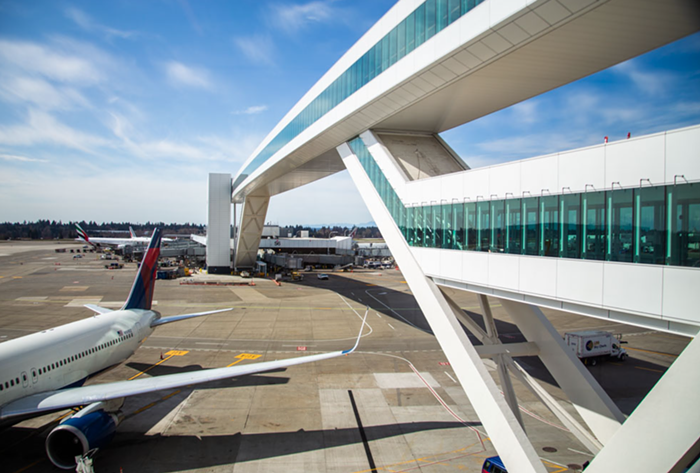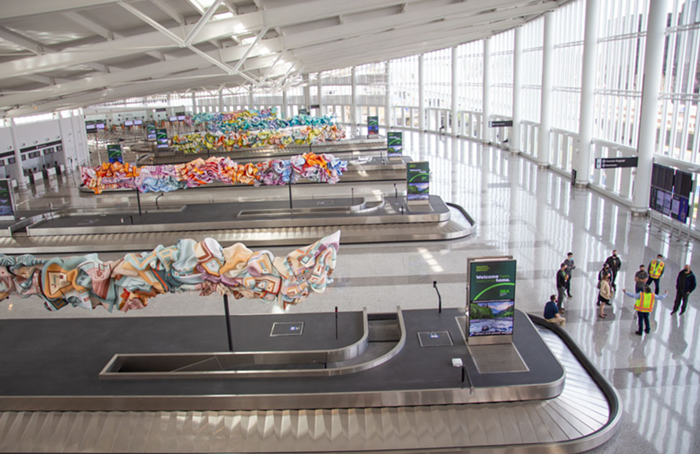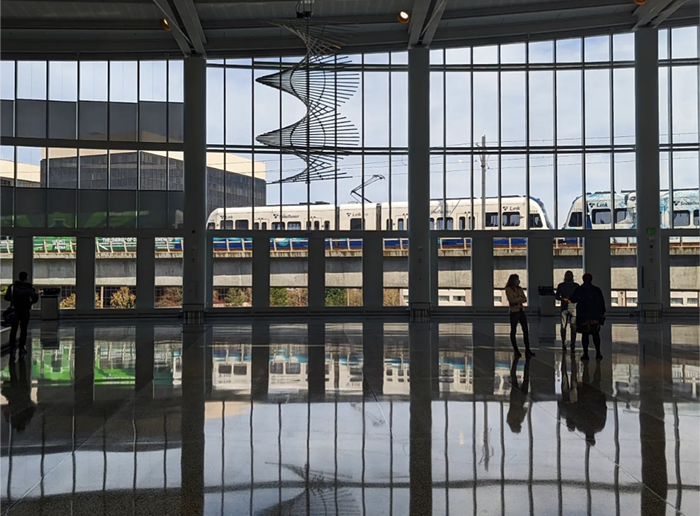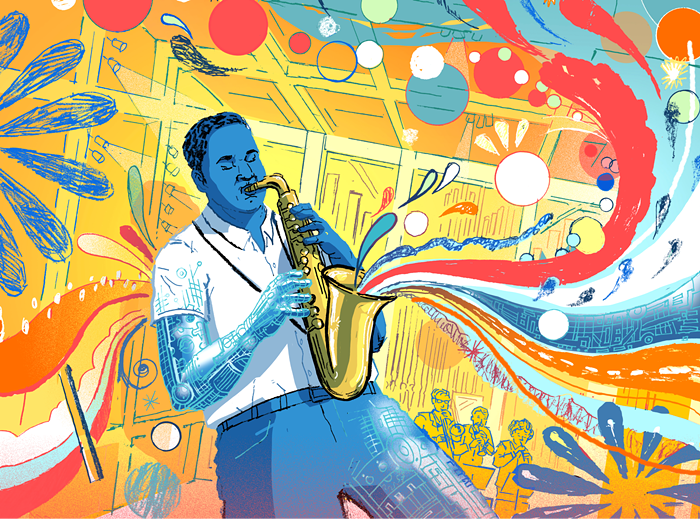The thinking behind Sea-Tac’s new International Arrivals Facility (IAF) is plain for all weary travelers to see. You are a foreigner. You have crossed too many time zones too quickly. You have finally arrived at what looks like the very end of the United States. You descend, disembark, and soon you enter a structure that has made every effort to announce an upgraded Pacific Northwest. This place was once about industry, but now it's about information.
To make sure you did not—indeed, could not—miss that message, Seattle's Port Commissioners selected Skidmore, Owings & Merrill (SOM) to design the place. That architecture firm is famous for two things: Building point-blank statements and looking forward in time, a mode some call modernism.
Fittingly, SOM first opened for business in 1936, and it operates out of the world's first fully modern city, Chicago. The firm designed what is still the tallest building in the world, Dubai’s Burj Khalifa—a symbol of the ever-rising power and confidence of Gulf petrodollars. SOM's architects also forged the spirit of Minoru Yamasaki's doomed Twin Towers, the One World Trade Center. Their impressive list of projects goes on and on. Taken together, it's almost as astounding as the new terminal's price tag: $1 billion.

Let's begin our art-and-architectural tour of the facilities with the IAF's record-breaking "Soaring Aerial Walkway," pictured above. Governor Jay Inslee was deeply impressed by the structure, which rises 38 feet in the air and spans 780 feet. You no longer use a subway to get to and from a gate to the authorities and baggage claim. Instead, you get off here and enter the world's longest walkway above an active taxi lane. (Gatwick Airport’s Pier 6 walkway used to hold that record.) “It is magnificent from an architectural perspective," said Inslee. "That walkway is a working piece of art.”
This kind of art falls easily into the category of late-period Space Age futurism. Indeed, if we could somehow teleport someone from the mid-1970s and give them the same view of the walkway that so impressed the Governor, that person would certainly think that the future depicted in Rick Guidice's paintings, such as Cutaway of Bernal Sphere Habitat (1976), had become a reality. It's easy to imagine the size and intensity of the disappointment they'd experience upon learning that the walkway wasn't for spaceships from suburbs and farms orbiting Mars or Jupiter, but rather for regular old planes from places right here on earth, such as Belize, Dubai, and Dublin.
Cutaway of Bernal Sphere Habitat by Rick Guidice 1976. #futureofthepast pic.twitter.com/iV1PuXef4D
— Sluts and Guts (@sluts_guts) July 6, 2020
On the walkway, which some are already calling "iconic" due to certain aesthetic similarities it shares with the Space Needle, on a clear day travelers will find windows that can see Mount Rainier and the Olympic Mountains. But here is the thing time-tired travelers will have to consider as they admire these fine examples of Pacific Northwest beauty. Scientists believe that the "snow on the Olympic Peninsula will be gone by 2070," and I believe the nobility of these mountains is all about the snow. This revelation leads to the unavoidable fact of climate change, and the role that air travel plays in this seemingly unstoppable catastrophe.
You may love the walkway and its futurism, but it also shows another future: An uninhabitable planet. There is the future in culture (the IAF) and the future in nature (snowless Olympics, heat-domed Seattle, smoke from forest fires). Unless we find ways to fly without releasing so much carbon into the sky, which is not impossible, the frequency with which we enter terminals like the IAF must be as low as possible. Going to a local Irish Pub should not be done with the same ease as flying to Dublin on Aer Lingus.
And yet, the international terminal's Grand Hall boasts a world-class operational capacity. It's built to process "2,600 passengers per hour" and, in the process, make the traveler feel a kind lightness or efficiency that's associated with an Information Age defined by apps, smartphones, and laptops.
What you first see in this Grand Hall is not the Seattle of Weyerhaeuser and Boeing but that of Microsoft and Amazon, a company that now employs the most people in town, and that transformed South Lake Union into one of the world's tech hubs along the way. Google is here, Meta is here, Apple is here. And so every effort was made for the IAF to display what can only be described as Seattle's post-Space Needle Futurism. The reflective terrazzo floors composed of locally mined stones, the shiny floor-to-lofty ceiling windows, and all the rest. In this airy space, Link trains fly north towards Northgate (and soon to Lynnwood) or south towards Angle Lake (and soon to Federal Way). The coming future stations, the reflections in the windows of the new trains from Germany, the hi-tech immigration processing — these are the elements of an information-oriented metropolis.
Though the overall statement of the IAF's Grand Hall speaks for a region that employs something like 200,000 tech workers, SOM, and also pubic art organized by Port Senior Art Program Manager Tommy Gregory, layer representations of the region's industrial and cultural past like an archeology site. For example, the passage that announces your arrival to the United States of America after you exit the walkway is lined with the wood of felled Douglas Firs. Complementing this woodwork is a topographical map of the Puget Sound region in two parts: One that emphasizes Mount Rainier, and another that emphasizes Seattle. And if you look closely at this split map you will see the footprints of... Bigfoot.
The Port's artwork also includes the recent and deep histories of the Pacific Northwest. There are woven pieces by Lisa Telford, and a glass-encased, blue-glass miniature totem pole by Preston Singletary called Kéet. That piece faces the Global Entry Kiosks and the Welcome Portal. Once you pass the security screening area with your bags, a Pacific Northwest garden of rocks and native conifers comes into view. All of this art and landscaping ends in the main terminal with a large glass box that contains what appear to be mammoth tusks exhumed from somewhere in Western Washington but are in fact made of glass.
"They are actually not real tusks," Gregory explained in an interview. "William Morris made them from glass. But for some reason, a lot of animal rights folks have made the mistake of thinking they are real and complained to commissioners. We have better labels now stating the blown glass material." The title of Morris's piece, which was installed in 2019, is Northwest Garnering.

But Gregory's master stroke is found in the two large public works inside of the Grand Hall. One Magnetic Anomaly (pictured at the top of this post), by the Bay Area artist Ned Kahn, fits perfectly with Grand Hall's futurist program: Smooth, mathematical, orderly, with a chaos gently controlled by magnets. Meanwhile, the sculptures plopped on top of the luggage carousels, Marela Zacarías's Chalchiutlicue, possess the convolutions of clouds. They vividly express various aspects of the Pacific Northwest world—its mountains, its bodies of water, its islands. In-between these two works is the new and the old, but the old is clearly only a layer of the past from which the future arose.




















